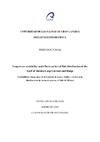Please use this identifier to cite or link to this item:
https://accedacris.ulpgc.es/handle/10553/7242
| Title: | Long-term variability and effects on larval fish distribution of the Gulf of Mexico Loop Current and Rings | Other Titles: | Variabilidad a largo plazo de la Corriente de Lazo y Anillos, y efectos en las distribuciones de larvas de peces en el Golfo de México | Authors: | Lindo Atichati, David | Director: | Sangrá Inciarte, Pablo Goni, Gustavo Jorge Muhling, Barbara |
UNESCO Clasification: | 2510 Oceanografía | Keywords: | Mesoscale eddies Gulf of Mexico Bluefin tuna Thunnus thynnus |
Issue Date: | 2012 | Project: | Fish Stock Assessment From Satellite Observations, Atlantic Oceanographic and Meteorological Laboratory(AOML) de la National Oceanic and Atmospheric Administration (NOAA) | Abstract: | The Gulf of Mexico (GOM) is an enclosed sea susceptible to climate change and anthropogenic pressures, as years of intense development and exploitation have resulted in significant change to the fisheries resources. It is the preferred spawning habitat for several commercially-important pelagic fish species (e.g. the Atlantic bluefin tuna). This basin is also characterized by a complex and highly variable system of currents and eddies, which affects the physical environment where fish spawn (Teo and Block 2010). The mesoscale circulation in the GOM is dominated by the Loop Current (LC) and rings shed by this major current. These powerful oceanic features carry anomalies in the physical, biological, and chemical properties of the region, and they affect -either directly or indirectly through their smaller-scale subsidiaries- just about every aspect of oceanography of the Gulf. For these reasons, the proposed investigation is focused on the satellite monitoring of the temporal and spatial variability of the LC and rings, and on the regulation of the larval fish distribution of some species by mesoscale oceanic features.The overarching aim of this dissertation is to investigate, assess and analyze linkages between ocean circulation and the spatial and temporal distribution of larval fish in the Gulf of Mexico. This connection is explored in here through the use of satellite derived observations and in situ biological sampling. The main goals of this research are to (1) monitor and describe the spatial and temporal variability of LC intrusions (northward), LC retreats (southward), and ring detachments; and (2) assess the influence of mesoscale ocean features on the distribution of larval fish spawned in the northern GOM in spring months from 1993 to 2007. El Golfo de México (GDM) es un mar cerrado susceptible al cambio climático y a presiones antropogénicas, como demuestra el hecho que años de intenso desarrollo y explotación se han traducido en cambios significativos en los recursos pesqueros. Esta cuenca es el hábitat de reproducción preferido de varias especies de peces pelágicos comercialmente importantes (e.g., el atún rojo atlántico), y se caracteriza por un sistema complejo y altamente variable de las corrientes y remolinos, lo cual afecta el entorno físico donde los peces desovan (Teo and Block 2010). La circulación de mesoescala en el GDM está dominada por la Corriente de Lazo (CL) y los anillos desprendidos por esta corriente principal. Estas energéticas estructuras oceánicas transportan anomalías en las propiedades físicas, biológicas y químicas de la región, y afectan –ya sea directa o indirectamente a través de estructuras dependientes de menor escala– a casi todos los aspectos de la oceanografía del GDM. Por estas razones, la investigación propuesta se centra en el control satelital de la variabilidad temporal y espacial de la CL y anillos, y en la regulación mediante estructuras oceánicas de mesoescala de la distribución de larvas de peces. El propósito general de esta tesis es investigar, evaluar y analizar los vínculos entre la circulación oceánica y la distribución espacial y temporal de larvas en el GDM. Esta conexión se explora aquí a través del uso de satélites y observaciones derivadas de un muestreo biológico in situ. Los principales objetivos de esta investigación son: (1) monitorizar y describir la variabilidad espacial y temporal de las intrusiones de la CL (hacia el norte), retiros de la CL (hacia el sur), y desprendimiento de anillos; y (2) evaluar la influencia de las estructuras oceánicas de mesoescala en la distribución de larvas desovadas en el norte del GDM (al norte de 24° N) durante los meses de primavera desde 1993 a 2007. |
Description: | Programa de doctorado: Oceanografía (bienio 2008-2010) | Department: | Física | Faculty: | Facultad de Ciencias del Mar | URI: | https://accedacris.ulpgc.es/handle/10553/7242 | Rights: | by-nc-nd |
| Appears in Collections: | Tesis doctoral |
Page view(s)
89
checked on Apr 27, 2024
Download(s)
144
checked on Apr 27, 2024
Google ScholarTM
Check
Share
Export metadata
Items in accedaCRIS are protected by copyright, with all rights reserved, unless otherwise indicated.
